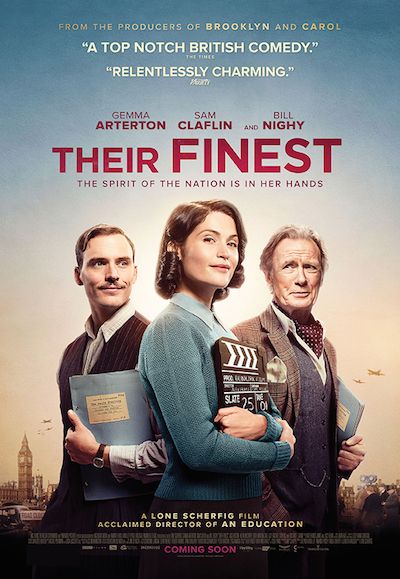A few months ago I was asked to talk to the cast and crew of a feature film entitled Darkest Hour (out this November), starring Gary Oldman as Winston Churchill and Kristin Scott Thomas as his wife Clementine. The director, Joe Wright, wanted me to provide a biographical analysis of the prime minister and some historical background to the crisis engulfing the country at the end of May 1940. Then, as France was collapsing under the German onslaught and the Dunkirk evacuation was taking place, Churchill imposed the decision to fight on, alone if necessary, despite pleas within his own war cabinet, notably from Lord Halifax, that Britain should seek a negotiated settlement with Hitler.
I tried to provide a helpful character study of Churchill in the context of this existential drama. But I suspect the occasion was more interesting to me than it was to my audience. In the wake of our session, I was asked what I thought of some large photographs of Churchill pinned up at the back of the room. Peering at them myopically, I expressed surprise that I had never seen these images before. This got a good laugh at my expense because they were, in fact, pictures of Gary Oldman in character. I was fooled not only by the familiar props—hat, cigar, bow tie and stick—but by Oldman’s uncannily Churchillian expression. He was the British bulldog to the life, an incarnation of strength, courage and tenacity.
These qualities will be badly needed as we stand alone once again during the Brexit debacle. Indeed, the difficulty of negotiating a happy outcome plainly emerged from Theresa May’s election mantra about strong and stable leadership. Her slogan “Forward Together” also echoed a famous Churchill poster. And while she didn’t get the majority she wanted, May still managed to garner more than 13m votes. So it may be more than a coincidence that at least three other films dealing with the war, all of them British or British-supported productions, are released in this non-anniversary year.
In April came Their Finest, starring Gemma Arterton and Bill Nighy, which tells the story of the making of a morale-boosting movie about the miracle of Dunkirk for the Ministry of Information, set against the background of the Blitz. In mid-June came Churchill, a study of the great man, ageing and harrowed by memories of the disastrous landings at Gallipoli in the First World War, as he confronts the prospect of D-Day, with Brian Cox in the title role supported by Miranda Richardson as Clementine. Finally, to cap them all, is Dunkirk, an epic treatment of the evacuation directed by Christopher Nolan (The Dark Knight trilogy, Inception and Interstellar) and starring Tom Hardy, Kenneth Branagh and Mark Rylance. It is billed as the most ambitious war film since Steven Spielberg’s Saving Private Ryan (1998). But perhaps Ridley Scott’s Battle of Britain, plans for which were recently unveiled, will in another year or two prove to be equally spectacular.
To me, Cox seems unconvincing as Churchill, and one can hardly imagine his wife saying, as she does in the trailer, “Try acting like a hero, Winston.” Still, heroism in the face of adversity has always been what makes war films such a success at the box office. They are akin to Westerns: located in familiar territory and featuring readily identifiable goodies and baddies, who engage in a climactic shoot-out. And since all cinema is contemporary cinema, these films shed more light on the preoccupations and anxieties of the present than the events of the past.
The radiant hallucinations projected on to the silver screen have often appeared more real than the humdrum life outside the local Odeon. This was especially true in the austere aftermath of the Second World War, when its grim experiences were replayed as escapist entertainment, exciting adventure and patriotic myth.
During the 1940s, 30m Britons went to the cinema each week (a figure which, with the advent of television, had halved by 1960). British war films were exceptionally popular at home—though not in America, with its aversion to Limey accents and attitudes. About a hundred were made in the two decades after Hitler’s defeat, and it was later quipped that if all the films about the Second World War were shown end to end they would have lasted longer than the war itself. Plainly they catered for the keen appetite of audiences to re-live their own recent experiences, or rather a glamorised version of them.
Stars such as Richard Todd, Jack Warner and Kenneth More were seldom out of uniform. Jack Hawkins claimed that he “played enough senior officers to stock the entire Ministry of Defence.” Trevor Howard and Dirk Bogarde left the country to avoid being typecast as soldiers. Bryan Forbes, who acted in a series of POW films, reckoned that he spent two whole years behind barbed wire, much of that time in The Wooden Horse (1950). John Mills took part in Ice Cold in Alex (1958) because it offered him a rare love scene—which was eventually cut.
"If all the films about the Second World War were shown end to end they would have lasted longer than the war itself"Women did get occasional starring roles: Anna Neagle and Virginia McKenna played secret agents in, respectively, Odette (1950) and Carve Her Name with Pride (1958). For the most part though war films were macho affairs, action-packed tales of valour and sacrifice. Typical was Powell and Pressburger’s The Battle of the River Plate (1956)—well received despite having, in the words of one critic, “such a stiff upper lip that it is almost expressionless.” But if the characters were stock in that film, every effort was made to enhance their pluck by creating life-like combat scenes, including the use of two of the original vessels. The Admiralty also contributed ships to other naval sagas, among them The Cruel Sea (1953) and Sink the Bismarck! (1960). Similarly the RAF supplied Lancaster bombers for The Dam Busters (1955), whose march became the unofficial anthem of the service, while Spitfires and Hurricanes were employed to illustrate Douglas Bader’s flying prowess in Reach for the Sky! (1957).
The airborne assault on Arnhem was re-enacted where it took place for Theirs is the Glory (1946), which employed no fewer than 200 veterans of the battle, who were paid a generous £3 a day. Clifton James played both himself and General Montgomery in I Was Monty’sDouble (1958). For added grittiness, contemporary newsreels were spliced into films such as the original Dunkirk (1958), directed by Leslie Norman, who portrayed the evacuation as both a bloody defeat and “a very gallant effort.” (It will be interesting to see whether Nolan’s forthcoming version of the story strikes a convincing balance between the gallantry and the defeat.) So plausible were some of these celluloid illusions that they usurped the truth, and not only in the public mind. Just as Sergei Eisenstein’s fictional picture of the 1917 storming of the Winter Palace (in Ten Days That Shook the World) during the Russian Revolution has often been presented as documentary fact, the BBC broadcast footage from The Dam Busters on the 50th anniversary of the raid without acknowledging its origin.
Of course, post-1945 war movies came in many shapes and sizes. Britain was fresh from a close shave, and escape stories were a staple, illustrating as they did the audacity and ingenuity of prisoners in camps such as Colditz, very few of whom actually made “home runs.” Equally favoured were special operations like that depicted in The Cockleshell Heroes (1955), which showed how commandos were brutally knocked into shape for missions that frequently proved fatal. By contrast comedies, from Private’s Progress (1956) to Carry On Sergeant (1958), gained added appeal by mildly subverting the ramrod conventions of the military. Standard fare also included spy stories, tales of cowardice and treachery, hospital romances, psychological studies and dramas about civilians caught up in the conflict, such as A Town Like Alice (1956). Finally no war film won more deserved plaudits than David Lean’s intricate masterpiece, The Bridge on the River Kwai (1957).
Yet despite their differences these post-war movies had a lot in common. They all assumed that we had fought for a just cause in a necessary war. On the screen there was no moral equivalence between the British and the Germans, let alone the Japanese. Nor was there anything approaching All Quiet on the Western Front, Hollywood’s definitive 1930 portrayal of the tragic futility of the First World War bloodbath. Then—as now—painful truths were avoided, such as the bombing of Dresden and the deliberate targeting of German working-class housing, which was arguably a war crime.
The Second World War might be hell but the enemy was Satan, a view validated in 1945 by the shocking appearance of newsreel pictures of the liberation of Belsen. The British government had not made much of Hitler’s Holocaust during the war, partly for fear of fuelling anti-Semitism at home, partly because it would seem like the kind of fake atrocity story that had been exposed after the First World War. But now the truth was out with a vengeance and it consecrated Churchill’s war as a triumphant crusade against evil.
In his war-time speeches Churchill himself had dramatised the lives of Britons in their finest hour. He pledged to fight on the beaches. He immortalised the Few, a word marvellously evocative of Shakespeare’s Henry V, which Laurence Olivier filmed in 1944 at the prime minister’s suggestion, creating a propagandist extravaganza in glorious Technicolor. Churchill inspired a mood of patriotic self-reliance and plausibly declared that there was “a white glow, overpowering, sublime, which ran through our island from end to end.” Post-1945 war films reflected this glow, focused on the Dunkirk spirit, and projected a chivalric image of Britannia at bay. Indeed, the message of Leslie Norman’s Dunkirk was that all would be well when the nation pulled together in a common endeavour.
This message was undermined by the fact that most films adhered to the social stereotype, embodied in RC Sherriff’s 1928 play Journey’s End about the First World War, that officers were gallant gentlemen and other ranks were comic relief. Of course the People’s War did not produce a classless society—proletarian cinema-goers were convulsed by the strangulated bourgeois love scenes in Brief Encounter (1945). But movie-makers invariably conjured with the solidarity forged in the heat of battle, thereby helping to shape our national identity. Even today we see ourselves through the prism of 1940, a year in which the nation not only survived but was morally on top of the world, fighting “alone” in what many consider to be the last good war.

War films, on which the official censors always kept a beady eye, crucially helped to sustain pride in British greatness as the exhausted country tried to win the peace while beset by grievous new troubles. In 1945 Britain was virtually bankrupt, facing what John Maynard Keynes called an “economic Dunkirk.” The British Empire started to disintegrate, losing the Indian jewel in its crown in 1947. The Cold War began and with it came the threat of nuclear annihilation. The yellow press harped on the twin dangers of state socialism and Commonwealth immigration. Lord Salisbury spoke for the right when he declared that “the main cause of the influx of Blacks is, of course, the welfare state”; and at stake “was the whole fabric of British society and who is entitled to be a British resident.” As the advance of the European Community on the continent from 1957 onwards emphasised the UK’s isolation and relative economic decline, nothing was better calculated to augment British self-confidence than Jack le Vien’s flag-wagging dramatised documentary about Churchill’s war-time premiership, The Valiant Years.
"Boris Johnson says Europe needs us more than we need Europe, and we should be ready to stand alone"That had been made for BBC television in 1961, by which time war films were starting to go out of fashion. Costs were prohibitive and a new generation no longer shared the memories of its predecessor. And all sorts of other factors counted against the genre as the 1960s progressed: Angry Young Men, Women’s Lib, Catch-22 (published in 1961), CND, anti-Vietnam War protests and dissident culture in general, particularly the satire boom.
Beyond the Fringe probably delivered the death blow to the old-style British war movie, imbued as it was with the code of sang froid and self-sacrifice. In its famous sketch “The Aftermyth of War” Jonathan Miller, playing a loyally obedient pilot, is instructed by his commanding officer, Peter Cook, to lay down his life for his country: “Get up in a crate, Perkins. Pop over to Bremen. Take a shufti. Don’t come back. We need a futile gesture at this stage. It will raise the whole tone of the war.” Thereafter the British widely re-imagined their contribution to the conflict in affectionately comic terms, via television series such as Dad’s Army and It Ain’t Half Hot Mum. Basil Fawlty provided wild caricature with his goose-stepping Nazi impersonation. Jim Hacker afforded admiring parody with the cod-Churchill voice he adopted in Yes, Minister when in leader mode.
Firmly in this tradition is Lone Scherfig’s Their Finest, just released, which is part send-up and part celebration of this sceptred isle under attack from the continent.
It is also, like many of its predecessors in the immediate post-war years, an exercise in nostalgia. It is a recapitulation of our will to win against fearful odds and a salute to the fortitude and concord of the English-speaking peoples. Churchill himself naturally wanted all this to be treated with due solemnity, which is why in 1943 he tried to ban The Life and Death of Colonel Blimp, a film he charged with mocking the officer class. That, however, was during the war itself. A few decades on the self-knowing and sometimes comic memories seemed to be winning out over the grandstanding.
But the Churchillian phantom was never quite laid to rest. Politicians like Tony Blair would sometimes summon it up at times of crisis. It reappeared on Vera Lynn’s 100th birthday in March. It materialised in bronze when Donald Trump restored Churchill’s bust to the Oval Office. In fact, for all the satire, Churchill remains an icon to conjure with, whether in Roy Jenkins’s flatulent biographical eulogy or in John Lithgow’s reverential portrayal in The Crown, where he fits snugly into what the writer Mary Wellesley called this “fetishistic hagiography” of the British monarchy. Similarly Boris Johnson extolled Churchill in what purported to be a serious study but is actually an error-prone piece of self-promotion written in the style of “Lord Snooty and his Pals” in the Beano.
Brexiteers like Johnson have assured us that Europe needs us more than we need Europe and that national salvation is to be found in standing alone. Perhaps, amid the current contagion of democratic self-harm and after an election in which May’s rhetoric has sounded distinctly Churchillian, their case will be assisted by this fresh crop of war films. But we should remember that these are lambent fantasies, not hard realities, shimmering mirages of lost British greatness.













